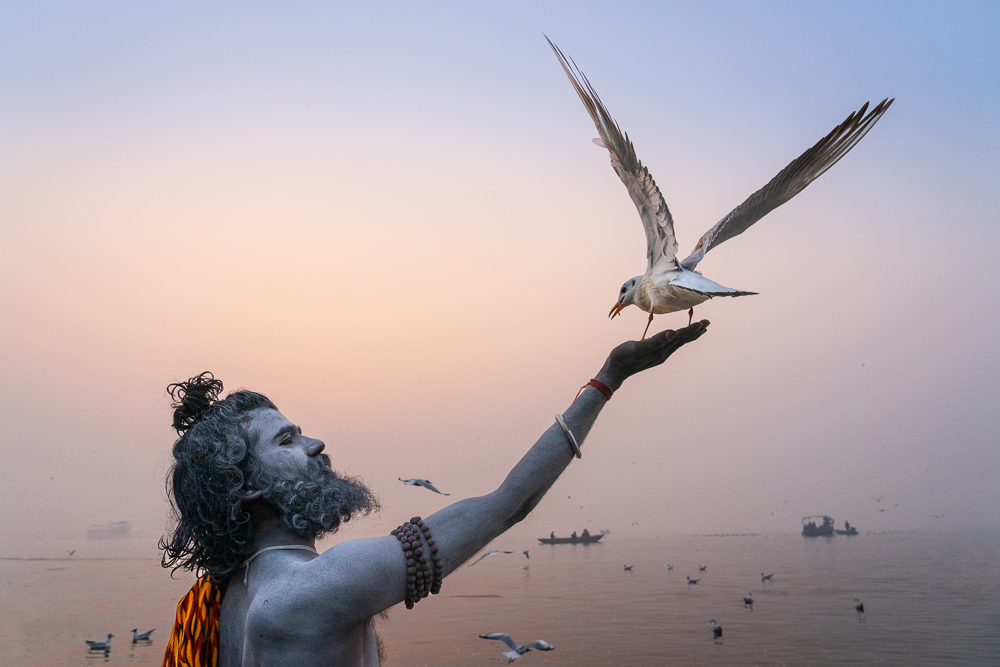Varanasi – Significance
Varanasi is a city in the northern India dating back to the 11th century B.C., making it one of the oldest continually inhabited cities in the world. It is considered by many to be the spiritual center of India, drawing people from all over to the sacred waters of the Ganges River for spiritual renewal. Bathing in the Ganges is believed to purify one’s soul from sins and facilitate spiritual growth. The river is considered a pathway to liberation (moksha), and the ashes of the deceased are often immersed in its waters to symbolize the soul’s journey towards eternal salvation. [https://anthyesti.com/2023/04/the-importance-of-body-cremation-in-the-ganges-river/]
Varanasi
As we arrive to the shore of the sacred Ganges River, a small boat goes by flocked by birds. It is as if we are transported to different place and time.

To reach our hotel, we must travel by boat as the back alleys are not wide enough for even a small tuk-tuk. The architecture is old and varied.

Our hotel is the smaller building located to the right of this castle like building.
Along the shores are sections called “Ghats” which are riverfront steps down to the water. One could think of it as amphitheatre seating with view of the water. People sit, eat, bath and sleep on the steps of the ghats.
We start our exploration of the city with an afternoon walk along many ghats down to the where the Aarti ritual is held at dusk.
The Aarti
The Aarti is a beautiful and complex daily devotional ritual performed by Hindu priests. It includes prayers and song, and dance with various movements and implements including incense, shell horns, feathers, bells and fire. Millions come each year to experience this one of kind ceremony.

With the fire, smoke and chanting prayers, it seems other worldly.
The Sadhus

A Sadhu on the ghats of Varanasi
Sadhus believe that by renouncing worldly possessions and societal attachments, they can focus entirely on spiritual practices (quora). They often cover themselves in the ash as a reminder of the ephemeral nature of life. The ash can be from a wood fire or even from the cremation of the deceased as this is considered most sacred.

Before sunrise we start out on the boat, Varanasi in the background.
It is before sunrise when we are joined in our boat by two Sadhus, They pose and they meditate as subjects for us on the Ganges river. The early monring light, the birds and the ancient city in the background make for some moving photos.

A moment between man and bird
The Cows
Cows are revered in Inida by the Hindus. Considered holy, they are fed offerings by people and allowed to roam free. There are over 300 million cattle in India and many roam the streets of the cities. As there are strict penalties for killing (or even injurying) a cow, they rule the streets, stopping people and traffic — everything from buses to tuk-tuks.

Awaiting a interesting person to walk into my scene, I am photobombed by a cow.

There are even places to park your cow while you take care of important business of the day. [photo by Jeff]
The cremation Ghats
Many people come from all over india to bathe in the Ganges and many come to cremate their dead. There are two main cremation Ghats on the river in Varanasi. It is not permitted to photograph the funeral pyres from within the Ghat area. From the water of the Ganges the cremation pyres creates quite an impact.

Stacks of wood are stored for purchase for each cremation.

The fires of the funeral pyres burn day and night.
Purification

Along the water, many people bath at the Ghats – believing in the spiritual cleansing of the water.

Flowers and candles are set afloat as offerings.
Varanasi is rich with cultural history. Although at times it seemed gritty and raw, its spiritual impact to the Hindu people is evident everywhere.


Excellent photos and great explanations.
Thank you! Varanasi was great for photography.